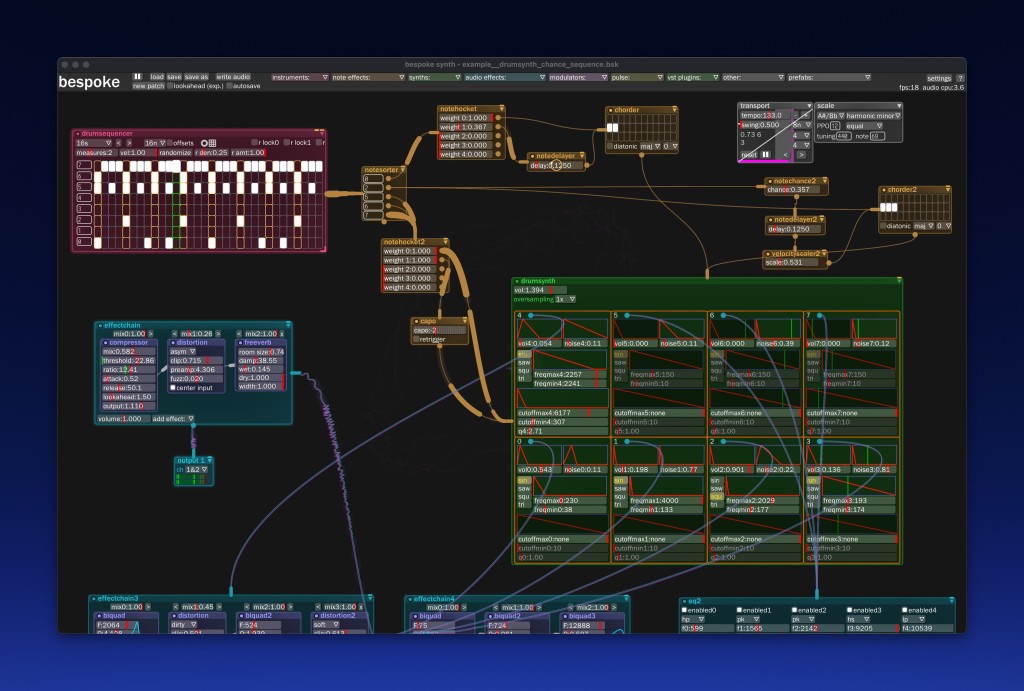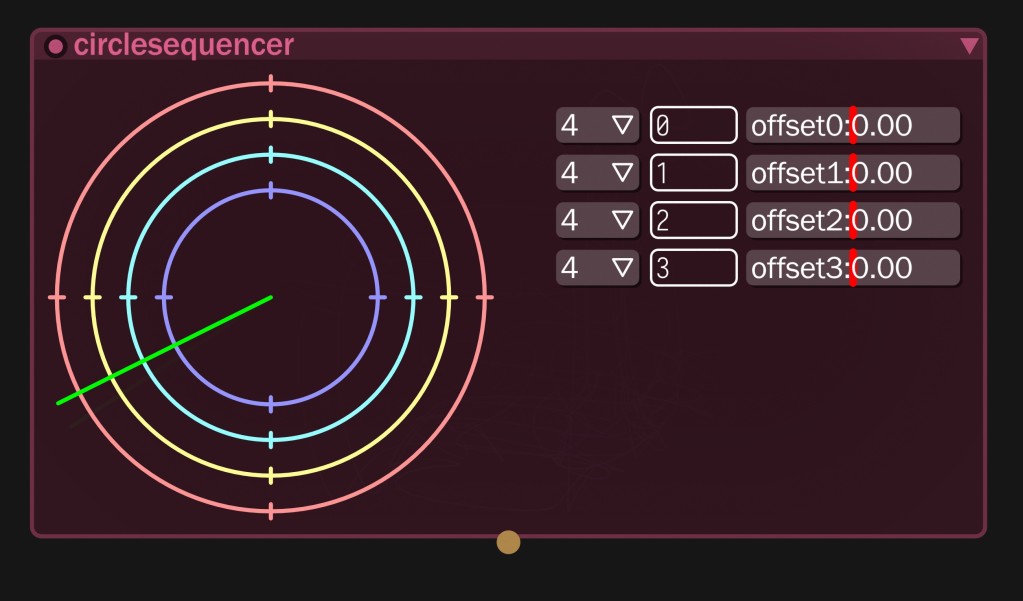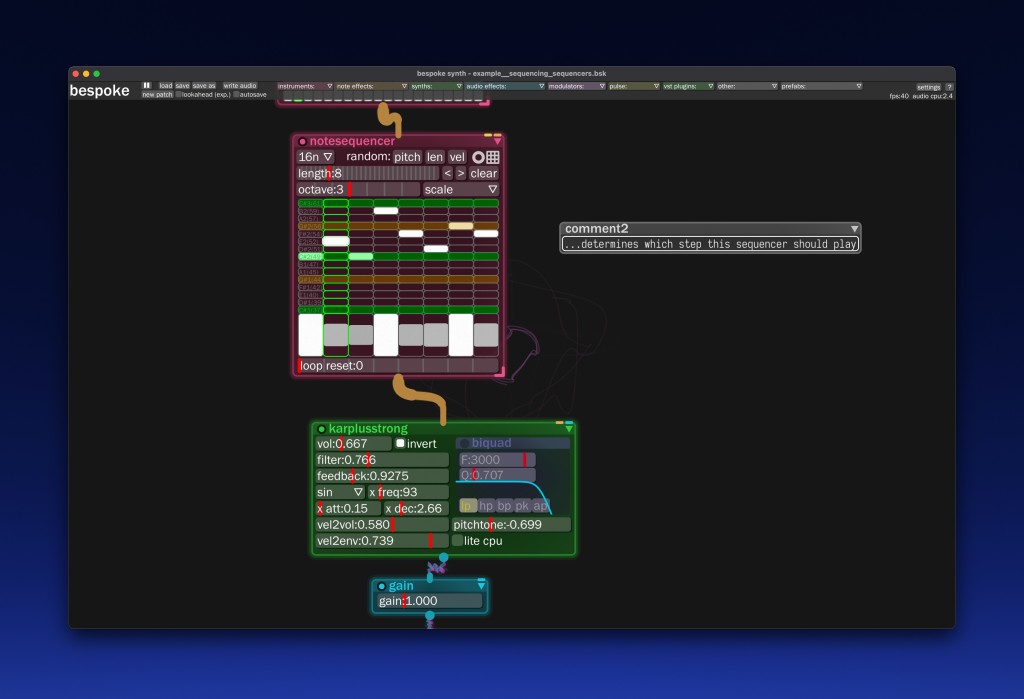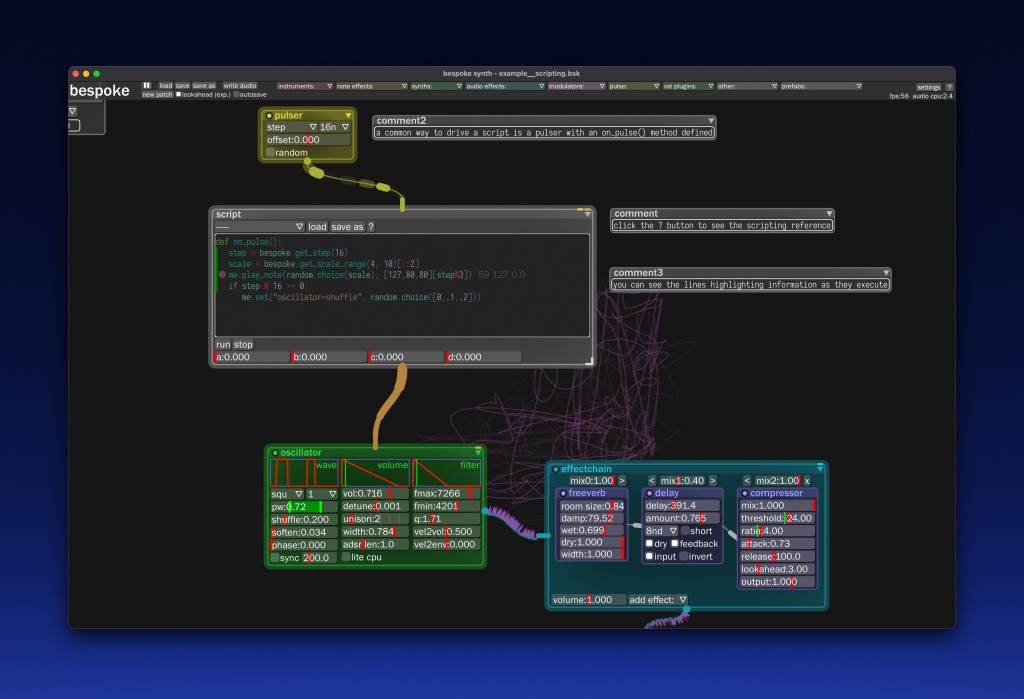If you need a break from big monolithic production environments, Bespoke wants to be your alternative – for free. Plenty of you liked that idea and responded, and the result hits this month with the major 1.1.0 milestone.
Led by developer Ryan Challinor, veteran of game dev Harmonix, Bespoke is a fresh new environment that brings together a lot of the ideas that have rejuvenated computer-based music making. That short list:
- Modular synthesis
- Non-linear arrangement
- Live looping
- Live jams
- Livecoding (in Python!)
- Plug-in hosting (so you can still use your VSTs)
- Open source development and community support
It’s all wrapped into a friendly, open-ended, blank-canvas environment. That also means you can just have at whatever bits interest you and not worry about the rest. But it also looks like a nice entry point into patching and livecoding even for those who hadn’t pondered that before.
Open-ended is the point, though – as Ryan puts it, “like if I smashed Ableton to bits with a baseball bat, and asked you to put it back together.”
“…like if I smashed Ableton to bits with a baseball bat, and asked you to put it back together.”
Ryan has been working on this for a full decade. Quite a few readers have been asking why I didn’t cover it at launch, to which I answered – oh yeah, why didn’t I? Ryan volunteered the answer – it was during Superbooth. (Ah, that’s why I remember a haze of beers, rainy east Berlin forests, and knobby hardware modules.)
But now is a good time to catch up with Bespoke for any of us who haven’t already, because this week 1.1.0 arrives with a ton of improved functionality and polish. Ryan got in touch to share what’s new, on the occasion of the release and an updated pricing model.


Free, open source, give to charity if you want
This is fully free and open-source stuff. With 1.1.0, it’s been reorganized to be a better-organized open-source project, too, including cmake building which makes it much easier to build from source. (It runs on Mac, Windows, and Linux.) Paul Walker and Matthias von Faber of the wonderful Surge synth project, also open source, got involved in that effort, says Ryan.
There’s a price adjustment, but now if you do spend money, funds directed to a good cause, the NAACP legal defense and education fund. That seems doubly sustainable – fighting for justice, remembering that electronic music wasn’t built alone and shouldn’t have a future without justice, and keeping pricing sustainable for all developers.
Where to get started
Like a lot of dataflow/visual patching environments, Bespoke is all about starting with nothing. That may mean you don’t know exactly what to do next, so best to start with this walkthrough:
Don’t be too afraid, though. Important things to know:
The interface is zoomable. (It looks so small in the screenshots, I know, but it is 2021 – zooming is a thing. I got nervous, too, as I have some vision problems.)
There are a bunch of examples. It’s not all “hey, let’s live code the sound of cats being stepped on inside a wormhole” – like, arpeggiator, 2-deck DJ rig, simple synths, all that stuff. Although… okay, yeah, now you should try to make that quantum cat screeching example, too. You can go either way.
You’ll find help built-in.


What’s new in 1.1.0
That “point-one-oh” bit sounds minor, but this is a big release. The full changelog is on GitHub:
https://github.com/BespokeSynth/BespokeSynth/releases/tag/v1.1.0
But let me cherry-pick the big stuff for you:
- Improved VST management and support
- VST transport following, MIDI out
- Python is packaged with the tool (no Python version/path Hell, hurrah)
- Improved UI, tips, and more
- New and improved modules – including new notetable, notetoggle, noteexpression
- Tuning support – SCL/KBM and Oddsound
- Channels beyond 16 ins/outs
- Visual improvements
- Tons and tons of fixes
Basically, this is a great release to get started with.
How this compares
Almost right out of the gate, I heard comparisons between Bespoke and VCV Rack. I think some of that was in the hopes that Bespoke development would be open to participation as a free project in ways that maybe Rack has not been. But they’re different animals. It’s not just aesthetics or friendliness to hardware lovers that makes the faux-Eurorack UI of Rack or Reaktor Blocks distinct. What you get is a different design methodology and workflow, too.
(I’m very curious to try teaching modular synthesis with Bespoke and not only Rack or Pd partly because each of these three is different!)
It’s interesting to see Ryan call this a “modular DAW.” It’s a pretty easy comparison to look at Bespoke as related to software like Usine Hollyhock, or even, going back in time a bit further, stuff like Plogue Bidule and AudioMulch. Usine is a lot broader in capabilities and has a deeper UI and works with lighting and visual elements as an AV tool, but the basic idea is the same. I’m sure there will even be overlap in user areas.
Bespoke is special partly because of its own character, the character of its modules, its minimalistic design (drawing a lot on TouchDesigner), and its focus. It seems of all the tools I just mentioned one of the most approachable in trying to work creatively in new ways. And I’ve never seen live coding and patching combined in quite this way.
Anyway, the usual rule applies. Don’t worry too much about tool choice. See what you like – with ample patience to wrap your head around an environment before you dismiss it.
But the pricing and development model, openness to community contributions and interoperability, and this gorgeous and unique design all hold a ton of promise. And after some ups and downs, it’s now a great time across the open source world, from Ardour to Pd, SuperCollider, VCV Rack, Surge, and now Bespoke, in various ways.
And yeah, you can patch together a clever host, load some plug-ins (even free proprietary ones), and wire together a digital DJ rig or looper – then decide later if you want to dabble in Python or fancier coding.
Sounds good to me. Plus more lockdowns are coming, so maybe software can keep us healthy, warm, and happy.